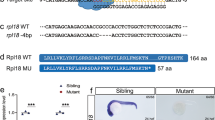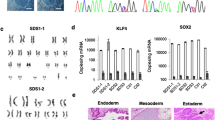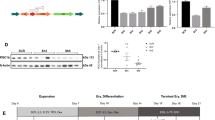Abstract
Congenital dyserythropoietic anemias (CDAs) are phenotypically and genotypically heterogeneous diseases1,2,3,4. CDA type II (CDAII) is the most frequent CDA. It is characterized by ineffective erythropoiesis and by the presence of bi- and multinucleated erythroblasts in bone marrow, with nuclei of equal size and DNA content, suggesting a cytokinesis disturbance5. Other features of the peripheral red blood cells are protein and lipid dysglycosylation and endoplasmic reticulum double-membrane remnants4,6. Development of other hematopoietic lineages is normal. Individuals with CDAII show progressive splenomegaly, gallstones and iron overload potentially with liver cirrhosis or cardiac failure. Here we show that the gene encoding the secretory COPII component SEC23B is mutated in CDAII. Short hairpin RNA (shRNA)-mediated suppression of SEC23B expression recapitulates the cytokinesis defect. Knockdown of zebrafish sec23b also leads to aberrant erythrocyte development. Our results provide in vivo evidence for SEC23B selectivity in erythroid differentiation and show that SEC23A and SEC23B, although highly related paralogous secretory COPII components, are nonredundant in erythrocyte maturation.
This is a preview of subscription content, access via your institution
Access options
Subscribe to this journal
Receive 12 print issues and online access
$209.00 per year
only $17.42 per issue
Buy this article
- Purchase on Springer Link
- Instant access to full article PDF
Prices may be subject to local taxes which are calculated during checkout



Similar content being viewed by others
References
Heimpel, H. & Wendt, F. Congenital dyserythropoietic anemia with karyorrhexis and multinuclearity of erythroblasts. Helv. Med. Acta 34, 103–115 (1968).
Wickramasinghe, S.N. Congenital dyserythropoietic anemias. Curr. Opin. Hematol. 7, 71–78 (2000).
Iolascon, A. Congenital dyserythropoietic anemias: a still unsolved puzzle. Haematologica 85, 673–674 (2000).
Heimpel, H. & Iolascon, A. in Disorders of Homeostasis, Erythrocytes, Erythropoiesis. 1st edn (eds. Beaumont, C., Beris, P., Beuzard, Y. & Brugnara, C.) Congenital dyserythropoietic anemia 120–142 (European School of Haematology, Paris, 2006).
Queisser, W., Spiertz, E., Jost, E. & Heimpel, H. Proliferation disturbances of erythroblasts in congenital dyserythropoietic anemia type I and II. Acta Haematol. 45, 65–76 (1971).
Iolascon, A. et al. Congenital dyserythropoietic anemia type II: molecular basis and clinical aspects. Haematologica 81, 543–559 (1996).
Heimpel, H. et al. Congenital dyserythropoietic anemia type II: epidemiology, clinical appearance, and prognosis based on long-term observation. Blood 102, 4576–4581 (2003).
Gasparini, P. et al. Localization of the congenital dyserythropoietic anemia II locus to chromosome 20q11.2 by genomewide search. Am. J. Hum. Genet. 61, 1112–1116 (1997).
Denecke, J. & Marquardt, T. Congenital dyserythropoietic anemia type II (CDAII/HEMPAS): Where are we now? Biochim. Biophys. Acta advance online publication doi:10.1016/j.bbadis.2008.12.005 (25 December 2008).
Denecke, J. et al. Characterization of the N-glycosylation phenotype of erythrocyte membrane proteins in congenital dyserythropoietic anemia type II (CDA II/HEMPAS). Glycoconj. J. 25, 375–382 (2008).
Lee, M.C., Miller, E.A., Goldberg, J., Orci, L. & Schekman, R. Bi-directional protein transport between the ER and Golgi. Annu. Rev. Cell Dev. Biol. 20, 87–123 (2004).
Fromme, J.C., Orci, L. & Schekman, R. Coordination of COPII vesicle trafficking by Sec23. Trends Cell Biol. 18, 330–336 (2008).
Cai, H., Reinisch, K. & Ferro-Novick, S. Coats, tethers, Rabs, and SNAREs work together to mediate the intracellular destination of a transport vesicle. Dev. Cell 12, 671–682 (2007).
Ishihara, N. et al. Autophagosome requires specific early Sec proteins for its formation and NSF/SNARE for vacuolar fusion. Mol. Biol. Cell 12, 3690–3702 (2001).
Penalver, E., Lucero, P., Moreno, E. & Lagunas, R. Clathrin and two components of the COPII complex, Sec23p and Sec24p, could be involved in endocytosis of the Saccharomyces cerevisiae maltose transporter. J. Bacteriol. 181, 2555–2563 (1999).
Mancias, J.D. & Goldberg, J. The transport signal on Sec22 for packaging into COPII-coated vesicles is a conformational epitope. Mol. Cell 26, 403–414 (2007).
Fromme, J.C. et al. The genetic basis of a craniofacial disease provides insight into COPII coat assembly. Dev. Cell 13, 623–634 (2007).
Lang, M.R., Lapierre, L.A., Frotscher, M., Goldenring, J.R. & Knapik, E.W. Secretory COPII coat component Sec23a is essential for craniofacial chondrocyte maturation. Nat. Genet. 38, 1198–1203 (2006).
Rhodes, J. et al. Interplay of pu.1 and gata1 determines myelo-erythroid progenitor cell fate in zebrafish. Dev. Cell 8, 97–108 (2005).
Boyadjiev, S.A. et al. Cranio-lenticulo-sutural dysplasia is caused by a SEC23A mutation leading to abnormal endoplasmic-reticulum-to-Golgi trafficking. Nat. Genet. 38, 1192–1197 (2006).
Skop, A.R., Liu, H., Yates, J. III., Meyer, B.J. & Heald, R. Dissection of the mammalian midbody proteome reveals conserved cytokinesis mechanisms. Science 305, 61–66 (2004).
Jones, B. et al. Mutations in a Sar1 GTPase of COPII vesicles are associated with lipid absorption disorders. Nat. Genet. 34, 29–31 (2003).
Bi, X., Corpina, R.A. & Goldberg, J. Structure of the Sec23/24-Sar1 pre-budding complex of the COPII vesicle coat. Nature 419, 271–277 (2002).
Mossessova, E., Bickford, L.C. & Goldberg, J. SNARE selectivity of the COPII coat. Cell 114, 483–495 (2003).
Bi, X., Mancias, J.D. & Goldberg, J. Insights into COPII coat nucleation from the structure of Sec23.Sar1 complexed with the active fragment of Sec31. Dev. Cell 13, 635–645 (2007).
Crookston, J.H., Crookston, M.C. & Rosse, W.F. Red-cell abnormalities in HEMPAS (hereditary erythroblastic multinuclearity with a positive acidified-serum test). Br. J. Haematol. 23 (Suppl.), 83–91 (1972).
Ronzoni, L. et al. Erythroid differentiation and maturation from peripheral CD34+ cells in liquid culture: cellular and molecular characterization. Blood Cells Mol. Dis. 40, 148–155 (2008).
Chomczynski, P. & Sacchi, N. Single-step method of RNA isolation by acid guanidiniumthiocyanate-phenol-chloroform extraction. Anal. Biochem. 162, 156–159 (1987).
Livak, K.J. & Schmitteng, T.D. Analysis of relative gene expression data using real-time quantitative PCR and the 2(−ΔΔC(T)). Methods 25, 402–408 (2001).
Paw, B.H. et al. Cell-specific mitotic defect and dyserythropoiesis associated with erythroid band3 deficiency. Nat. Genet. 34, 59–64 (2003).
Eswar, N., Eramian, D., Webb, B., Shen, M.Y. & Sali, A. Protein structure modeling with MODELLER. Methods Mol. Biol. 426, 145–159 (2008).
Pepperkok, R. et al. Beta-COP is essential for biosynthetic membrane transport from the endoplasmic reticulum to the Golgi complex in vivo. Cell 74, 71–82 (1993).
Keller, P., Toomre, D., Diaz, E., White, J. & Simons, K. Multicolour imaging of post-Golgi sorting and trafficking in live cells. Nat. Cell Biol. 3, 140–149 (2001).
Acknowledgements
We acknowledge the technical assistance of S. Braun, I. Janz, T. Kersten, G. Baur, T. Becker and R. Leichtle. Anti-ts-O45-G monoclonal antibody 'VG' was a gift from K. Simons (Max Planck Institute of Molecular Cell Biology and Genetics). HeLa-Kyoto cells (human cervix carcinoma cells) were from S. Narumiya (Kyoto University) and T. Hirota (Institute of Molecular Pathology). These studies were supported by the German Red Cross Blood Service Baden-Wuerttemberg-Hessen to K.S., by the University of Ulm to H.H. and by the Else Kröner Fresenius Stiftung to K.S. and H.H. Additional support was provided by the Italian Ministero dell'Università e della Ricerca, by Telethon (Italy), by grants MUR-P35/126/IND and by grants Convenzione CEINGE-Regione Campania-Ass. Sanità to A.I. University of Utah Core facilities were supported by an US National Institutes of Health grant. K.-P.H. acknowledges support from the Deutsche Forschungsgemeinschaft (SFB 684). We thank the DIM Facility for imaging microscopy and the Flow Cytometry Facility for cell cycle analyses at CEINGE Institute.
Author information
Authors and Affiliations
Contributions
K.S., A.I. and H.H. designed the study. H.H., A.I., S.P. and J. Delaunay treated subjects, collected clinical data and, together with J. Denecke, performed clinical laboratory analyses. K. Holzmann performed and K. Holzmann and K.S. analyzed the chip experiments. K.S., F.V., R.R., M.R.E., D.S., L.D.F., K. Heinrich, B.J., U.P. and R.P. performed the molecular, protein and cell analyses. K.-P.H. modeled the SEC23B structure. N.S.T. and W.H. performed zebrafish morpholino injections, blood cell preparations and electron microscopy. W.C. and B.H.P. performed the zebrafish western blot analysis. M.T.R. did the FACS analyses and fibroblast differentiation. K.S., A.I. and H.H. wrote the paper.
Corresponding authors
Supplementary information
Supplementary Text and Figures
Supplementary Note, Supplementary Tables 1–5 and Supplementary Figures 1 and 2 (PDF 2315 kb)
Rights and permissions
About this article
Cite this article
Schwarz, K., Iolascon, A., Verissimo, F. et al. Mutations affecting the secretory COPII coat component SEC23B cause congenital dyserythropoietic anemia type II. Nat Genet 41, 936–940 (2009). https://doi.org/10.1038/ng.405
Received:
Accepted:
Published:
Issue Date:
DOI: https://doi.org/10.1038/ng.405
This article is cited by
-
Congenital dyserythropoietic anemia type II in a newborn with a novel compound heterozygous mutation in the SEC23B: a case report and review of the literature
International Journal of Hematology (2024)
-
Functional screening of congenital heart disease risk loci identifies 5 genes essential for heart development in zebrafish
Cellular and Molecular Life Sciences (2023)
-
Prenatal diagnosis and postnatal outcomes of right aortic arch anomalies
Archives of Gynecology and Obstetrics (2022)
-
Confounding factors in the diagnosis and clinical course of rare congenital hemolytic anemias
Orphanet Journal of Rare Diseases (2021)
-
Murine SEC24D can substitute functionally for SEC24C during embryonic development
Scientific Reports (2021)



